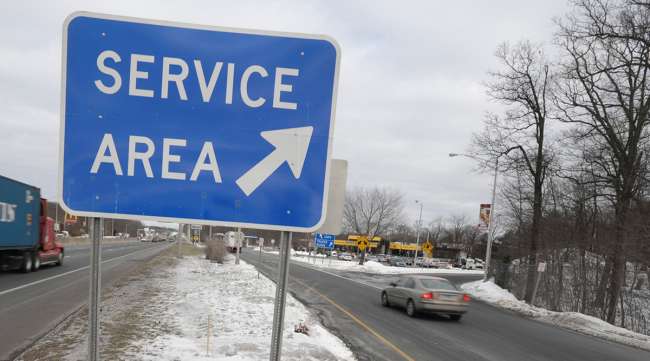Illinois Considering Closing Some Highway Rest Areas

The state of Illinois is considering how to rehab, or possibly close, some state rest areas, and has even launched a public survey about travelers’ likes and dislikes of the interstate highway stops — drawing thousands of responses so far.
“Many of our rest areas have reached a point where it’s time to evaluate their future,” said Illinois Transportation Secretary Randy Blankenhorn, in a statement.
The state has received nearly 4,500 responses to its survey in less than two weeks, and roadside restrooms have proved to be a popular topic.
Many of the state’s 30 public rest areas and 11 welcome centers on highways throughout Illinois are 30 to 40 years old, said Illinois Department of Transportation spokeswoman Kelsea Gurski. They are open 24 hours a day and have restroom facilities, picnic areas, maps and security cameras, along with parking for recreational vehicles and commercial trucks.
They offer a green, parklike alternative to retail locations such as fast-food outlets along the highway.
“As they reach the end of their useful life, we want to know how best to meet the needs of the traveling public — what features are valued by the public,” said Gurski. She said this will help the state develop plans to figure out what do with them in the next five to 20 years.
IDOT spokeswoman Gianna Urgo said in an email that the survey will be part of a comprehensive rest area study to analyze the existing system. She said a schedule for when rest stops may be rehabilitated cannot be determined until the end of the entire study, which will look at the costs of maintaining the rest areas compared to the services they provide.
This will include analyzing the survey results, documenting existing rest area services, identifying other available facilities, collecting traffic volumes and parking use, interviewing the trucking industry, collecting fatigue-related crash data and talking with other states to identify all possible options, Urgo said.
“Once the data has been collected and analyzed, strategies can be made about the future of the rest area system,” she wrote in an email.
Urgo said the survey, announced Oct. 11, received 4,417 responses as of Tuesday morning. The state will keep taking responses at idot.illinois.gov through Sunday, Oct. 29. Paper copies of the surveys are available at some rest areas or can be mailed upon request by calling 402-399-1405.
The 20-question survey asks travelers about the importance of family restrooms with diaper-changing stations, water fountains, playgrounds, maps and historical information. It also asks if travelers would like private businesses to be developed at or adjacent to the areas, which current law does not permit.
Rest areas were constructed as part of the Interstate Highway System beginning in the late 1950s and modeled after roadside parks, according to the website restareahistory.org, which is maintained by Joanna Dowling, a Chicago-based historian. Following the Highway Beautification Act of 1965, each state was required to develop a master plan for rest area development. Illinois built most of its rest areas in the 1970s and mid-1980s, Urgo said.
Closing rest areas and welcome centers is a growing trend in states seeking to address budget shortfalls, according to restareahistory.org. The road trip landscape has changed, with more fast-food chains and other retail destinations being built off highway ramps.
Ohio had 294 rest areas on its highways in 1961 — today it has 89, said Ohio transportation department spokesman Matt Bruning. He said this was due to changing driver demand.
“The private sector has done more and more to develop rest areas around our exit ramps,” Bruning said. “The need for a state-facilitated rest area has gone down.”
A representative of the Metropolitan Planning Council said the Chicago-based public policy research group would prefer that the state not close any rest areas, or at least do a careful analysis before making any decisions.
“Rest areas provide a place for people to avoid crashes caused by fatigue,” said Audrey Wennink, the council’s transportation director. She said they also provide an opportunity for people to make calls and send texts while they are stopped, which is much safer than doing that while they are driving.
Out at the Prairie View Rest Stop southbound off I-57 in Monee, the reviews were mixed. Linda Tucker of Cicero stopped at the facility on a recent weekday to stretch her legs but would not use the women’s bathroom, which was poorly lit by three overhead florescent lights. Two corners, one by the sinks to the left and the other at the end of the stalls to the right, were dark and smelled of stale urine, masked just barely by a floral scent.
Though Tucker said she often passes the stop on her way to her son’s home in Kankakee, she rarely uses the bathroom because it is “like a dungeon.”
Tucker, 59, a grandmother of eight, joked with other travelers that they might be better off relieving themselves out of doors.
“Go out back where the dogs go,” said Tucker. “It’s much better.”
She said the current human facilities are too dark and dingy. “It needs an upgrade.”
There were additional problems discovered by a reporter during a recent visit, such as the condition of the indoor water fountains. One was out of order, while the other was covered in a dusty film with flies circling the spout.
Some travelers said they wished the facility supplied bags to pick up after dogs — some visitors bring their own bags, but others don’t bother and let pets leave messes.
Other visitors expressed gratitude for Prairie View, one of the state’s oldest. It was built in 1970. The one-building facility is unremarkable, and its beige, brown and brick interior is a bit dull. But most travelers said they did not care; they just needed a place to use the restroom.
A couple of truckers at the stop expressed concern that there were not enough parking places for them to take federally required rest breaks.
“It’s more trucks, more trucks— every year more trucks — and we need more spots,” said Peter Fornal, a truck driver out of Florida. “It’s very hard for us to find a spot and take the rest, you know.”
The grounds behind the building are grassy and well-tended, with a few picnic tables and a playground. Just off the roaring interstate, the spot is an idyllic respite for travelers, said Jon Olsen, a retired Chicago firefighter.
Olsen, who regularly travels south to his winter home in Fort Myers Beach, Fla., in a recreational vehicle, stops frequently to let his two dogs take a walk. He said he had found that states farther south have closed many rest stops.
“I don’t expect them to be perfect,” Olsen said. “I’m just glad they haven’t closed this one down.”
Distributed by Tribune Content Agency, LLC




